Project Quality Management: Comparative Analysis Report
VerifiedAdded on 2022/11/17
|16
|4048
|65
Report
AI Summary
This report provides a comprehensive analysis of project quality management through a comparative study of the Queensland Children’s Hospital and the Perth Children’s Hospital projects. The report begins with an introduction outlining the background, purpose, and scope of the analysis, followed by a detailed literature review of each project. The literature review examines the planning, execution, and outcomes of both projects, highlighting key factors contributing to their success or failure. The report then identifies gaps in the existing literature and presents a comparison, contrast, and critique of both projects, employing tools like the Ishikawa diagram to illustrate project constraints and quality analysis. It assesses whether the projects reflect global project quality principles and standards, including the PMBOK framework. The discussion section explores the links to global practices, the effect on project deliverables, and lessons learned for future projects. The conclusion summarizes the findings and provides recommendations for improving project quality management. The report utilizes extensive literature review and analysis to provide a detailed understanding of project success and failure factors.

Running head: PROJECT QUALITY MANAGEMENT
Project Quality Management
Name of the Student
Name of the University
Author Note
Project Quality Management
Name of the Student
Name of the University
Author Note
Paraphrase This Document
Need a fresh take? Get an instant paraphrase of this document with our AI Paraphraser
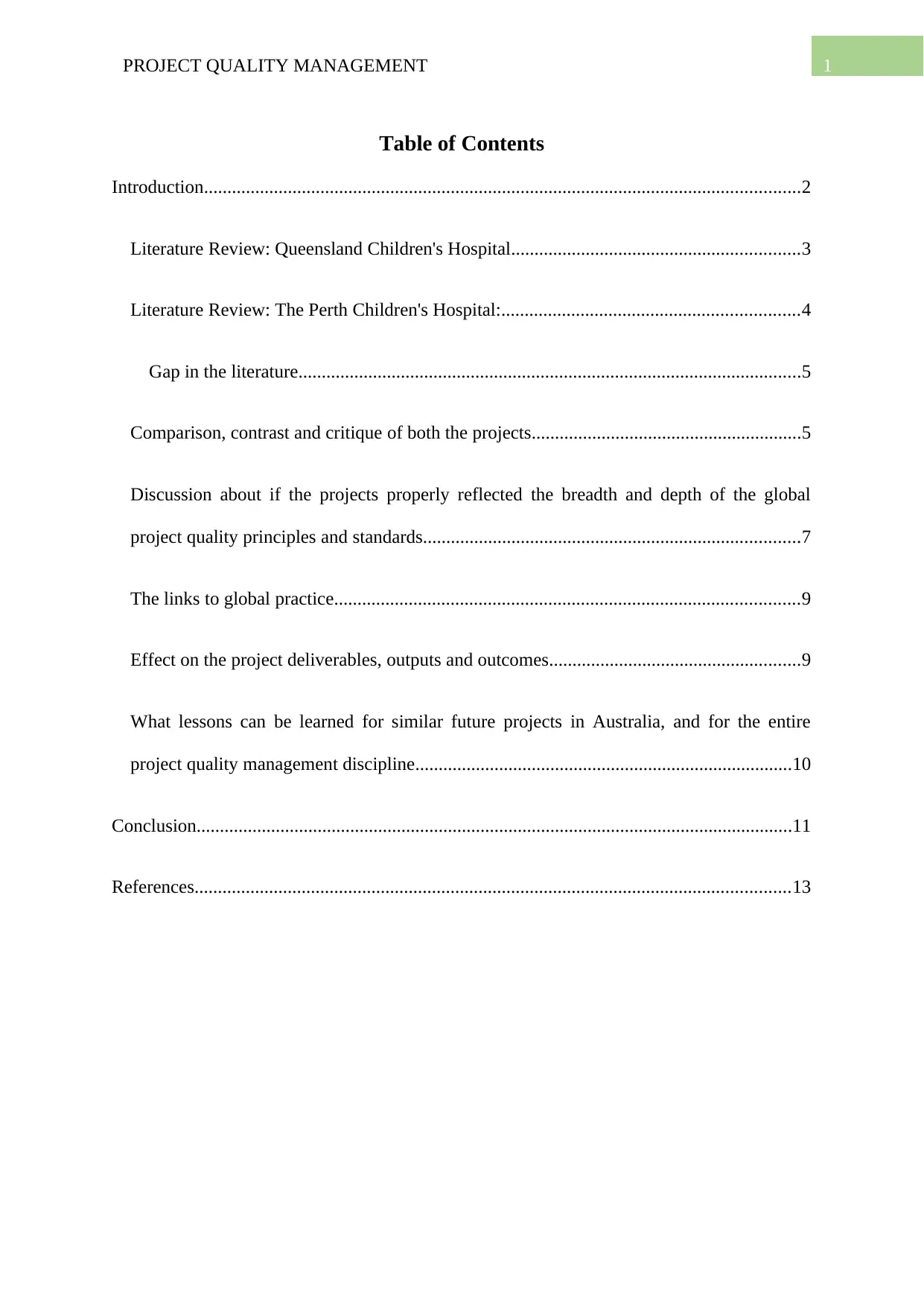
1PROJECT QUALITY MANAGEMENT
Table of Contents
Introduction................................................................................................................................2
Literature Review: Queensland Children's Hospital..............................................................3
Literature Review: The Perth Children's Hospital:................................................................4
Gap in the literature............................................................................................................5
Comparison, contrast and critique of both the projects..........................................................5
Discussion about if the projects properly reflected the breadth and depth of the global
project quality principles and standards.................................................................................7
The links to global practice....................................................................................................9
Effect on the project deliverables, outputs and outcomes......................................................9
What lessons can be learned for similar future projects in Australia, and for the entire
project quality management discipline.................................................................................10
Conclusion................................................................................................................................11
References................................................................................................................................13
Table of Contents
Introduction................................................................................................................................2
Literature Review: Queensland Children's Hospital..............................................................3
Literature Review: The Perth Children's Hospital:................................................................4
Gap in the literature............................................................................................................5
Comparison, contrast and critique of both the projects..........................................................5
Discussion about if the projects properly reflected the breadth and depth of the global
project quality principles and standards.................................................................................7
The links to global practice....................................................................................................9
Effect on the project deliverables, outputs and outcomes......................................................9
What lessons can be learned for similar future projects in Australia, and for the entire
project quality management discipline.................................................................................10
Conclusion................................................................................................................................11
References................................................................................................................................13
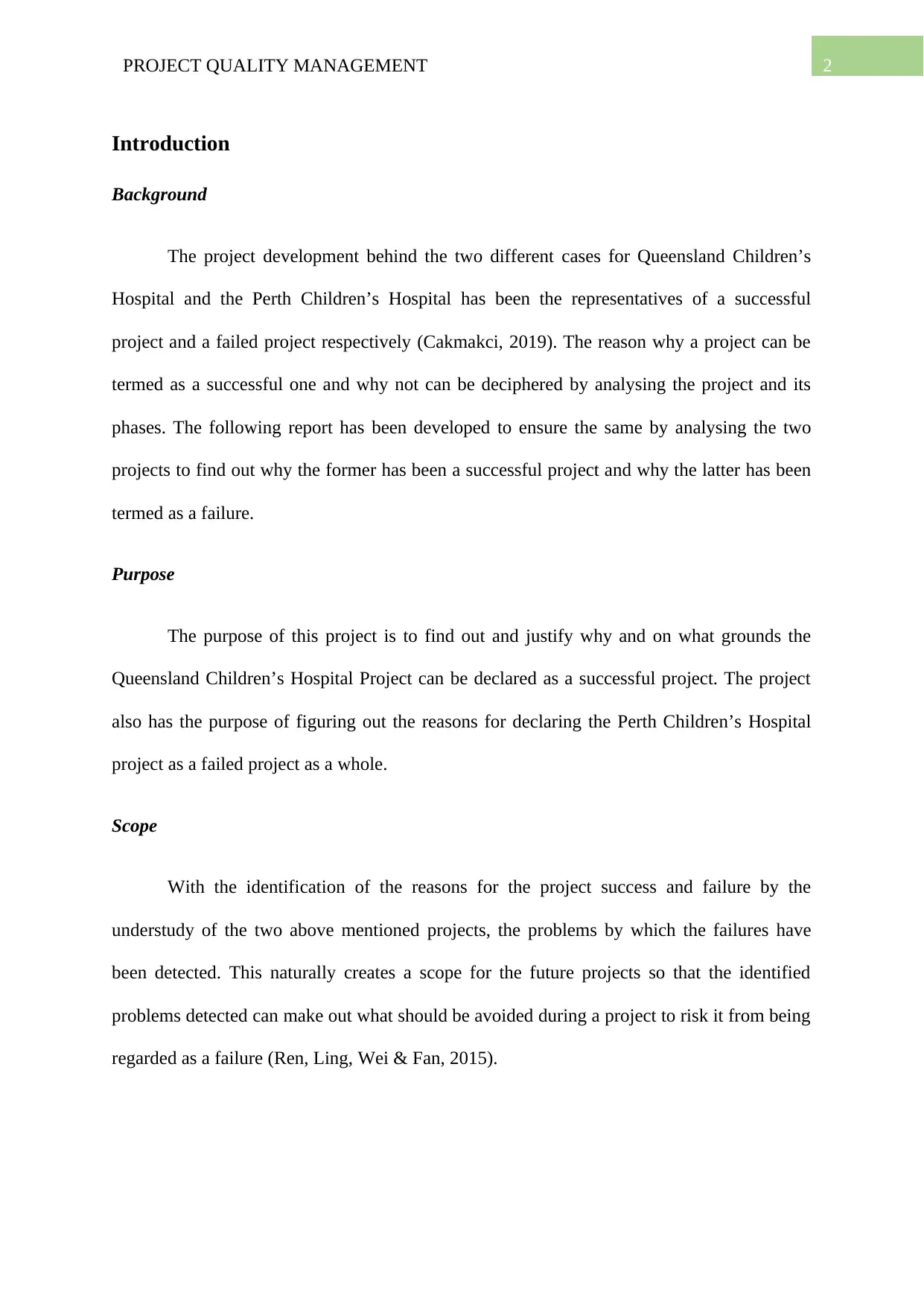
2PROJECT QUALITY MANAGEMENT
Introduction
Background
The project development behind the two different cases for Queensland Children’s
Hospital and the Perth Children’s Hospital has been the representatives of a successful
project and a failed project respectively (Cakmakci, 2019). The reason why a project can be
termed as a successful one and why not can be deciphered by analysing the project and its
phases. The following report has been developed to ensure the same by analysing the two
projects to find out why the former has been a successful project and why the latter has been
termed as a failure.
Purpose
The purpose of this project is to find out and justify why and on what grounds the
Queensland Children’s Hospital Project can be declared as a successful project. The project
also has the purpose of figuring out the reasons for declaring the Perth Children’s Hospital
project as a failed project as a whole.
Scope
With the identification of the reasons for the project success and failure by the
understudy of the two above mentioned projects, the problems by which the failures have
been detected. This naturally creates a scope for the future projects so that the identified
problems detected can make out what should be avoided during a project to risk it from being
regarded as a failure (Ren, Ling, Wei & Fan, 2015).
Introduction
Background
The project development behind the two different cases for Queensland Children’s
Hospital and the Perth Children’s Hospital has been the representatives of a successful
project and a failed project respectively (Cakmakci, 2019). The reason why a project can be
termed as a successful one and why not can be deciphered by analysing the project and its
phases. The following report has been developed to ensure the same by analysing the two
projects to find out why the former has been a successful project and why the latter has been
termed as a failure.
Purpose
The purpose of this project is to find out and justify why and on what grounds the
Queensland Children’s Hospital Project can be declared as a successful project. The project
also has the purpose of figuring out the reasons for declaring the Perth Children’s Hospital
project as a failed project as a whole.
Scope
With the identification of the reasons for the project success and failure by the
understudy of the two above mentioned projects, the problems by which the failures have
been detected. This naturally creates a scope for the future projects so that the identified
problems detected can make out what should be avoided during a project to risk it from being
regarded as a failure (Ren, Ling, Wei & Fan, 2015).
⊘ This is a preview!⊘
Do you want full access?
Subscribe today to unlock all pages.

Trusted by 1+ million students worldwide
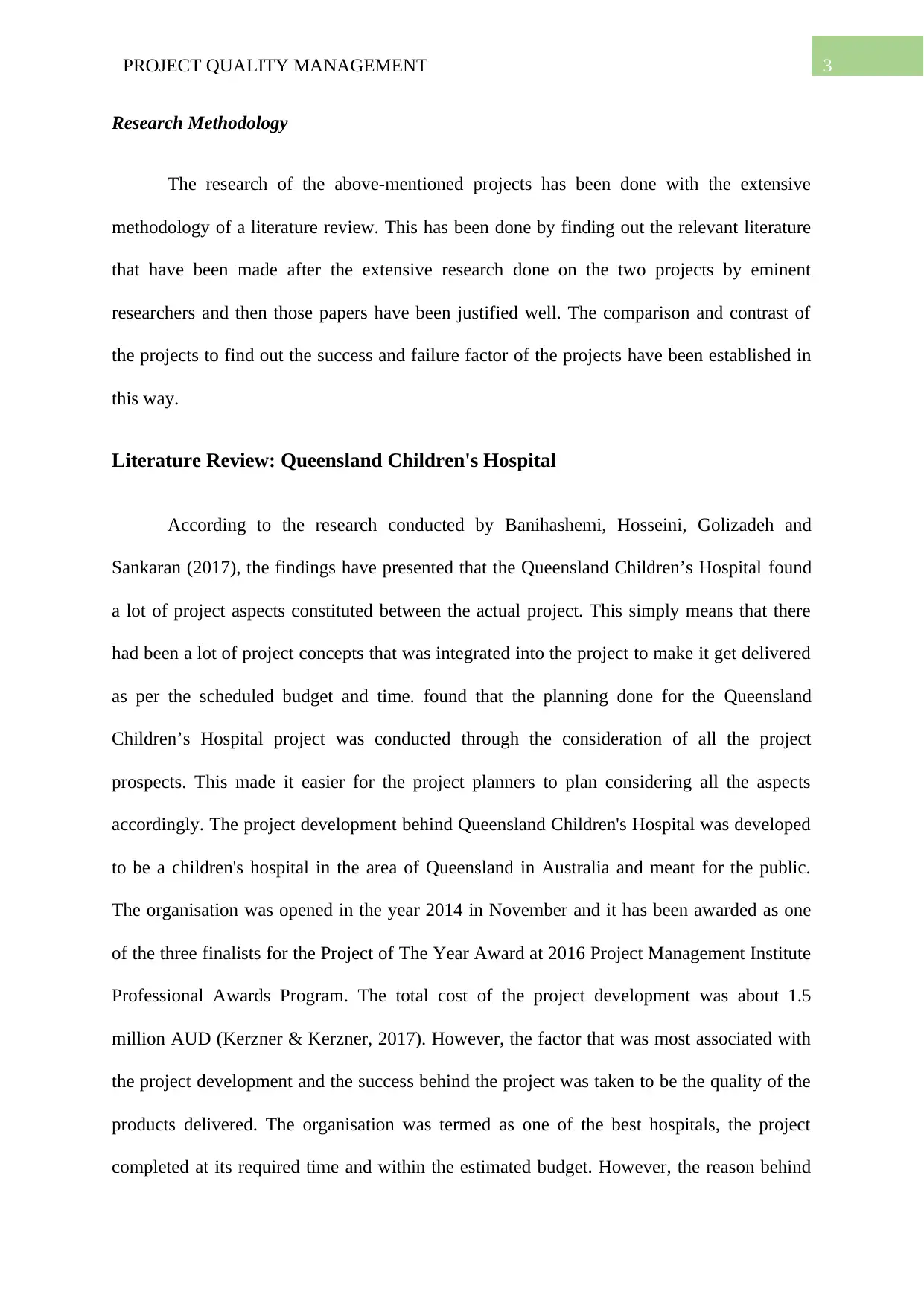
3PROJECT QUALITY MANAGEMENT
Research Methodology
The research of the above-mentioned projects has been done with the extensive
methodology of a literature review. This has been done by finding out the relevant literature
that have been made after the extensive research done on the two projects by eminent
researchers and then those papers have been justified well. The comparison and contrast of
the projects to find out the success and failure factor of the projects have been established in
this way.
Literature Review: Queensland Children's Hospital
According to the research conducted by Banihashemi, Hosseini, Golizadeh and
Sankaran (2017), the findings have presented that the Queensland Children’s Hospital found
a lot of project aspects constituted between the actual project. This simply means that there
had been a lot of project concepts that was integrated into the project to make it get delivered
as per the scheduled budget and time. found that the planning done for the Queensland
Children’s Hospital project was conducted through the consideration of all the project
prospects. This made it easier for the project planners to plan considering all the aspects
accordingly. The project development behind Queensland Children's Hospital was developed
to be a children's hospital in the area of Queensland in Australia and meant for the public.
The organisation was opened in the year 2014 in November and it has been awarded as one
of the three finalists for the Project of The Year Award at 2016 Project Management Institute
Professional Awards Program. The total cost of the project development was about 1.5
million AUD (Kerzner & Kerzner, 2017). However, the factor that was most associated with
the project development and the success behind the project was taken to be the quality of the
products delivered. The organisation was termed as one of the best hospitals, the project
completed at its required time and within the estimated budget. However, the reason behind
Research Methodology
The research of the above-mentioned projects has been done with the extensive
methodology of a literature review. This has been done by finding out the relevant literature
that have been made after the extensive research done on the two projects by eminent
researchers and then those papers have been justified well. The comparison and contrast of
the projects to find out the success and failure factor of the projects have been established in
this way.
Literature Review: Queensland Children's Hospital
According to the research conducted by Banihashemi, Hosseini, Golizadeh and
Sankaran (2017), the findings have presented that the Queensland Children’s Hospital found
a lot of project aspects constituted between the actual project. This simply means that there
had been a lot of project concepts that was integrated into the project to make it get delivered
as per the scheduled budget and time. found that the planning done for the Queensland
Children’s Hospital project was conducted through the consideration of all the project
prospects. This made it easier for the project planners to plan considering all the aspects
accordingly. The project development behind Queensland Children's Hospital was developed
to be a children's hospital in the area of Queensland in Australia and meant for the public.
The organisation was opened in the year 2014 in November and it has been awarded as one
of the three finalists for the Project of The Year Award at 2016 Project Management Institute
Professional Awards Program. The total cost of the project development was about 1.5
million AUD (Kerzner & Kerzner, 2017). However, the factor that was most associated with
the project development and the success behind the project was taken to be the quality of the
products delivered. The organisation was termed as one of the best hospitals, the project
completed at its required time and within the estimated budget. However, the reason behind
Paraphrase This Document
Need a fresh take? Get an instant paraphrase of this document with our AI Paraphraser
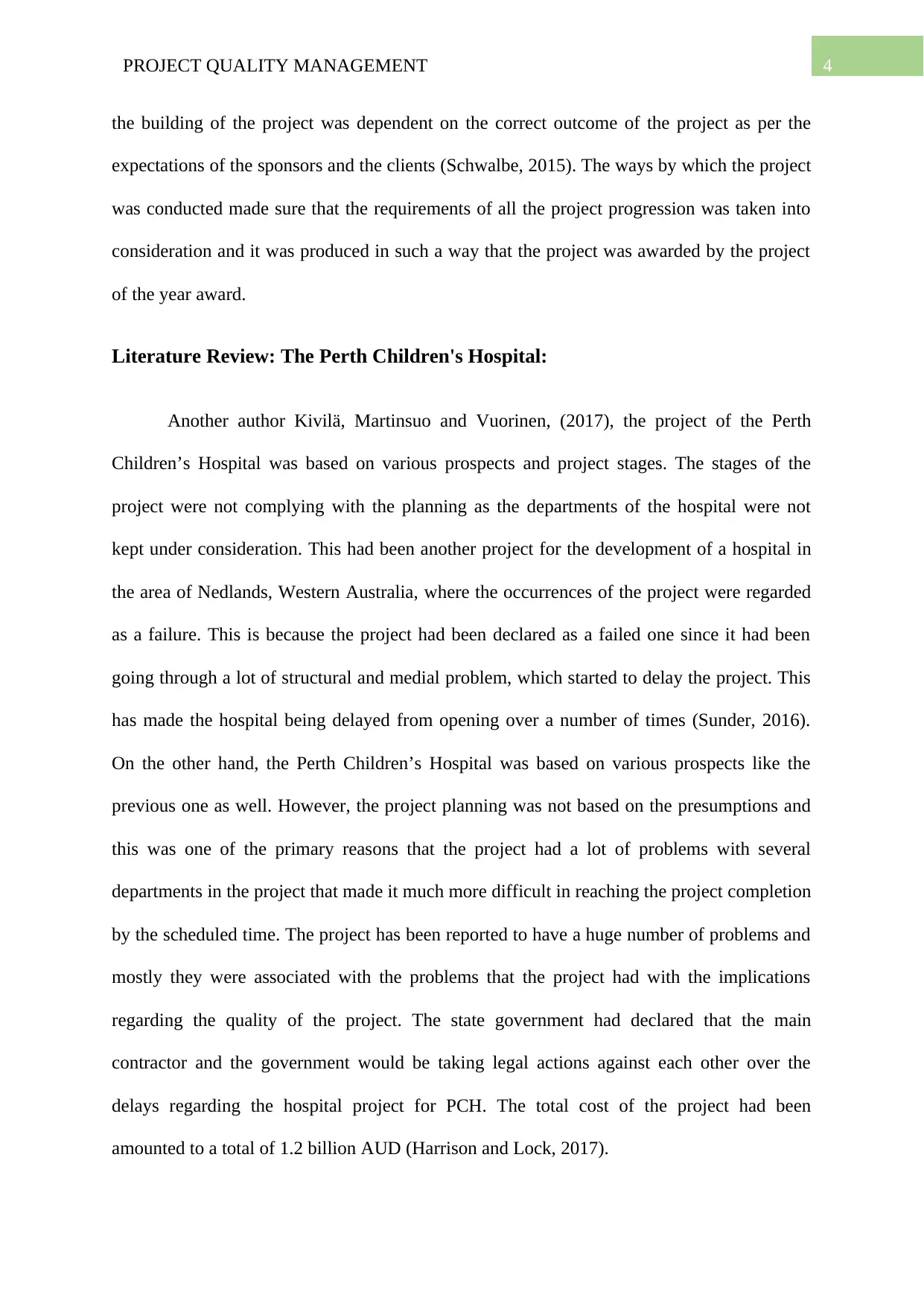
4PROJECT QUALITY MANAGEMENT
the building of the project was dependent on the correct outcome of the project as per the
expectations of the sponsors and the clients (Schwalbe, 2015). The ways by which the project
was conducted made sure that the requirements of all the project progression was taken into
consideration and it was produced in such a way that the project was awarded by the project
of the year award.
Literature Review: The Perth Children's Hospital:
Another author Kivilä, Martinsuo and Vuorinen, (2017), the project of the Perth
Children’s Hospital was based on various prospects and project stages. The stages of the
project were not complying with the planning as the departments of the hospital were not
kept under consideration. This had been another project for the development of a hospital in
the area of Nedlands, Western Australia, where the occurrences of the project were regarded
as a failure. This is because the project had been declared as a failed one since it had been
going through a lot of structural and medial problem, which started to delay the project. This
has made the hospital being delayed from opening over a number of times (Sunder, 2016).
On the other hand, the Perth Children’s Hospital was based on various prospects like the
previous one as well. However, the project planning was not based on the presumptions and
this was one of the primary reasons that the project had a lot of problems with several
departments in the project that made it much more difficult in reaching the project completion
by the scheduled time. The project has been reported to have a huge number of problems and
mostly they were associated with the problems that the project had with the implications
regarding the quality of the project. The state government had declared that the main
contractor and the government would be taking legal actions against each other over the
delays regarding the hospital project for PCH. The total cost of the project had been
amounted to a total of 1.2 billion AUD (Harrison and Lock, 2017).
the building of the project was dependent on the correct outcome of the project as per the
expectations of the sponsors and the clients (Schwalbe, 2015). The ways by which the project
was conducted made sure that the requirements of all the project progression was taken into
consideration and it was produced in such a way that the project was awarded by the project
of the year award.
Literature Review: The Perth Children's Hospital:
Another author Kivilä, Martinsuo and Vuorinen, (2017), the project of the Perth
Children’s Hospital was based on various prospects and project stages. The stages of the
project were not complying with the planning as the departments of the hospital were not
kept under consideration. This had been another project for the development of a hospital in
the area of Nedlands, Western Australia, where the occurrences of the project were regarded
as a failure. This is because the project had been declared as a failed one since it had been
going through a lot of structural and medial problem, which started to delay the project. This
has made the hospital being delayed from opening over a number of times (Sunder, 2016).
On the other hand, the Perth Children’s Hospital was based on various prospects like the
previous one as well. However, the project planning was not based on the presumptions and
this was one of the primary reasons that the project had a lot of problems with several
departments in the project that made it much more difficult in reaching the project completion
by the scheduled time. The project has been reported to have a huge number of problems and
mostly they were associated with the problems that the project had with the implications
regarding the quality of the project. The state government had declared that the main
contractor and the government would be taking legal actions against each other over the
delays regarding the hospital project for PCH. The total cost of the project had been
amounted to a total of 1.2 billion AUD (Harrison and Lock, 2017).
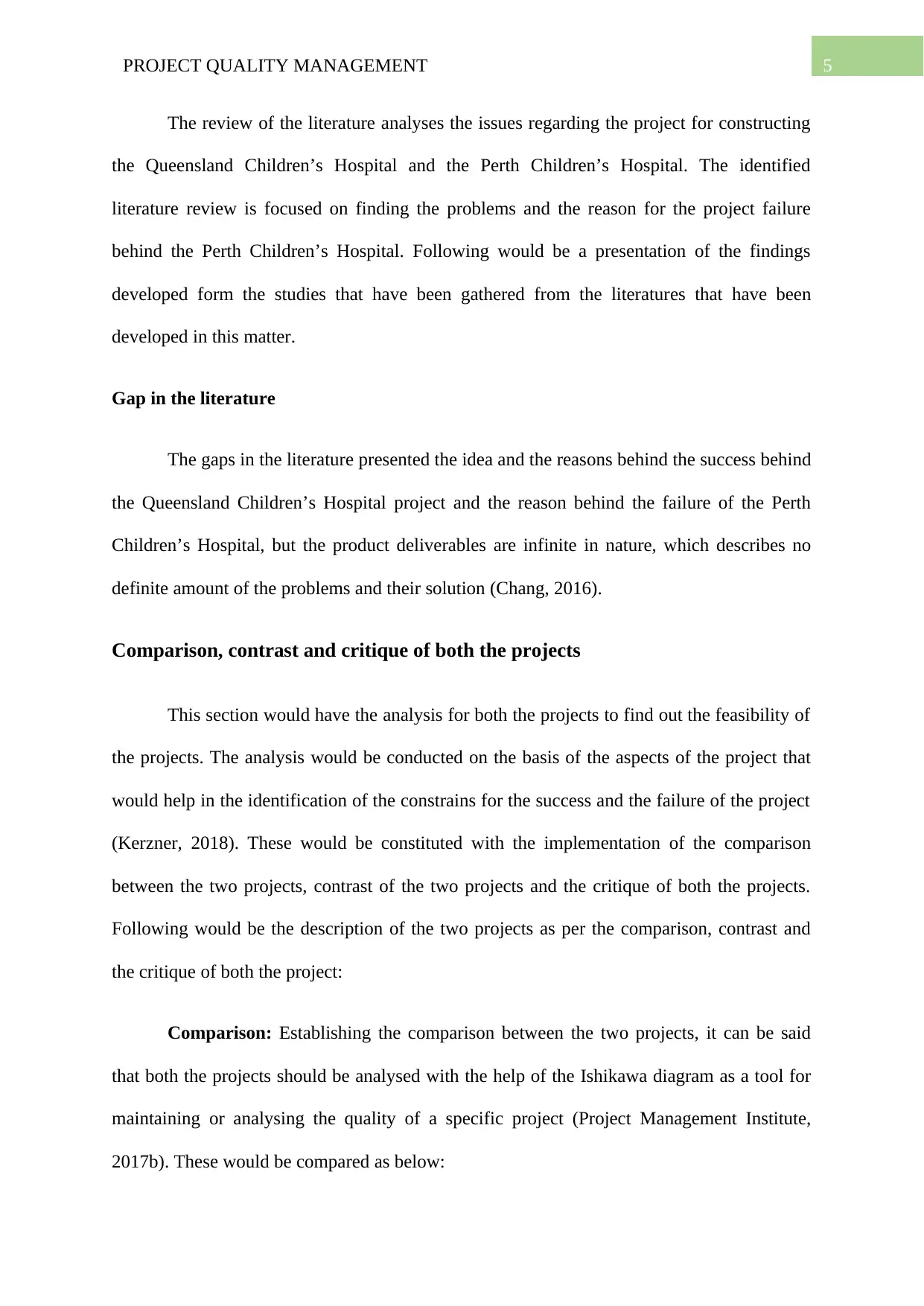
5PROJECT QUALITY MANAGEMENT
The review of the literature analyses the issues regarding the project for constructing
the Queensland Children’s Hospital and the Perth Children’s Hospital. The identified
literature review is focused on finding the problems and the reason for the project failure
behind the Perth Children’s Hospital. Following would be a presentation of the findings
developed form the studies that have been gathered from the literatures that have been
developed in this matter.
Gap in the literature
The gaps in the literature presented the idea and the reasons behind the success behind
the Queensland Children’s Hospital project and the reason behind the failure of the Perth
Children’s Hospital, but the product deliverables are infinite in nature, which describes no
definite amount of the problems and their solution (Chang, 2016).
Comparison, contrast and critique of both the projects
This section would have the analysis for both the projects to find out the feasibility of
the projects. The analysis would be conducted on the basis of the aspects of the project that
would help in the identification of the constrains for the success and the failure of the project
(Kerzner, 2018). These would be constituted with the implementation of the comparison
between the two projects, contrast of the two projects and the critique of both the projects.
Following would be the description of the two projects as per the comparison, contrast and
the critique of both the project:
Comparison: Establishing the comparison between the two projects, it can be said
that both the projects should be analysed with the help of the Ishikawa diagram as a tool for
maintaining or analysing the quality of a specific project (Project Management Institute,
2017b). These would be compared as below:
The review of the literature analyses the issues regarding the project for constructing
the Queensland Children’s Hospital and the Perth Children’s Hospital. The identified
literature review is focused on finding the problems and the reason for the project failure
behind the Perth Children’s Hospital. Following would be a presentation of the findings
developed form the studies that have been gathered from the literatures that have been
developed in this matter.
Gap in the literature
The gaps in the literature presented the idea and the reasons behind the success behind
the Queensland Children’s Hospital project and the reason behind the failure of the Perth
Children’s Hospital, but the product deliverables are infinite in nature, which describes no
definite amount of the problems and their solution (Chang, 2016).
Comparison, contrast and critique of both the projects
This section would have the analysis for both the projects to find out the feasibility of
the projects. The analysis would be conducted on the basis of the aspects of the project that
would help in the identification of the constrains for the success and the failure of the project
(Kerzner, 2018). These would be constituted with the implementation of the comparison
between the two projects, contrast of the two projects and the critique of both the projects.
Following would be the description of the two projects as per the comparison, contrast and
the critique of both the project:
Comparison: Establishing the comparison between the two projects, it can be said
that both the projects should be analysed with the help of the Ishikawa diagram as a tool for
maintaining or analysing the quality of a specific project (Project Management Institute,
2017b). These would be compared as below:
⊘ This is a preview!⊘
Do you want full access?
Subscribe today to unlock all pages.

Trusted by 1+ million students worldwide

6PROJECT QUALITY MANAGEMENT
For the Queensland Children’s Hospital, the quality analysis of the project is
maintained by the PMBOK methods by which the quality control of any project can be
analysed (Banihashemi, Hosseini, Golizadeh & Sankaran, 2017). This is shown as per the
Ishikawa Diagram analysing the project aspects for the project of Queensland Children’s
Hospital.
Figure 1: Project Quality Management analysis for Queensland Children’s Hospital
(Source: Created by Author)
Success in maintaining project quality
For the Queensland Children’s Hospital, the quality analysis of the project is
maintained by the PMBOK methods by which the quality control of any project can be
analysed (Banihashemi, Hosseini, Golizadeh & Sankaran, 2017). This is shown as per the
Ishikawa Diagram analysing the project aspects for the project of Queensland Children’s
Hospital.
Figure 1: Project Quality Management analysis for Queensland Children’s Hospital
(Source: Created by Author)
Success in maintaining project quality
Paraphrase This Document
Need a fresh take? Get an instant paraphrase of this document with our AI Paraphraser
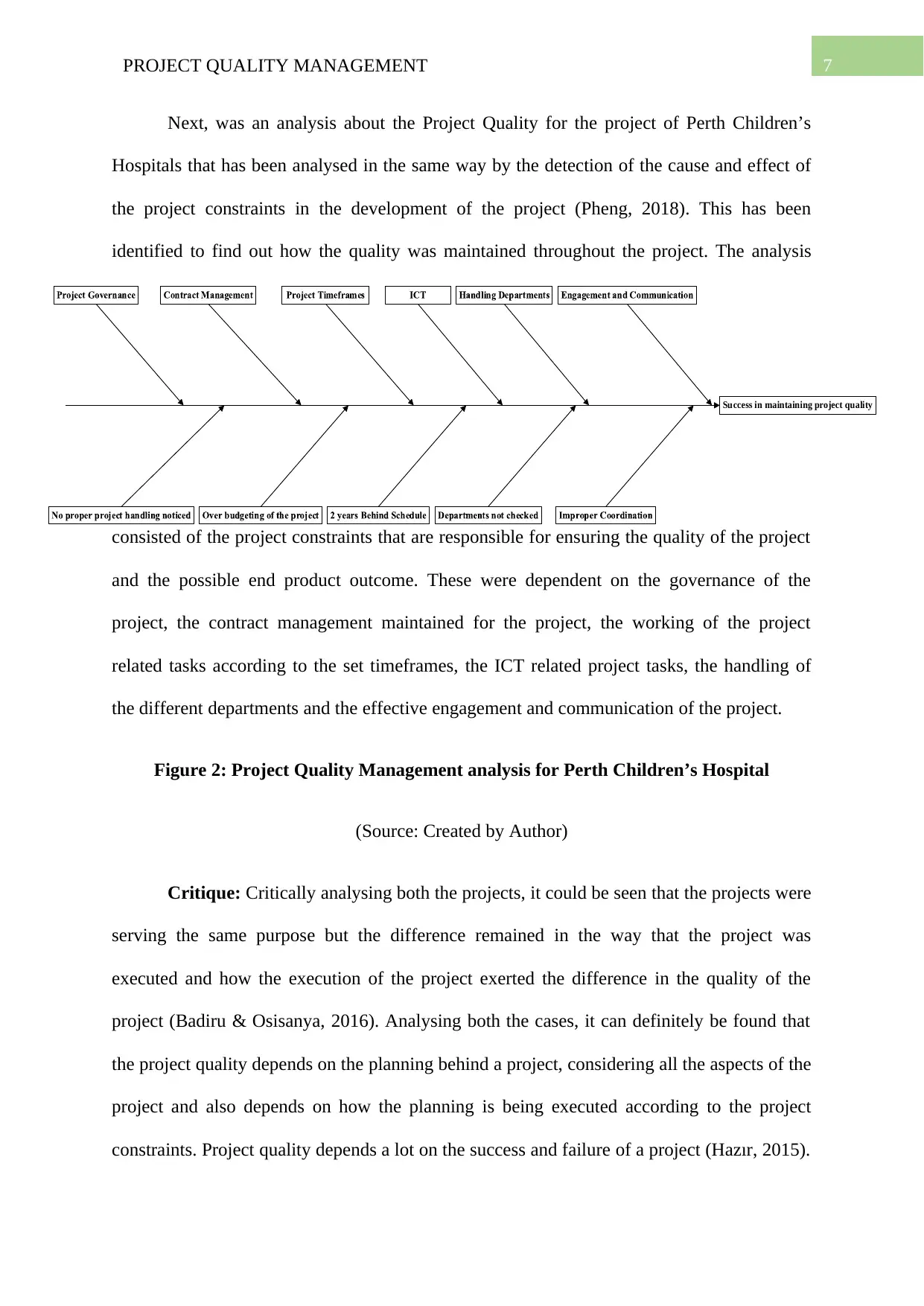
7PROJECT QUALITY MANAGEMENT
Next, was an analysis about the Project Quality for the project of Perth Children’s
Hospitals that has been analysed in the same way by the detection of the cause and effect of
the project constraints in the development of the project (Pheng, 2018). This has been
identified to find out how the quality was maintained throughout the project. The analysis
consisted of the project constraints that are responsible for ensuring the quality of the project
and the possible end product outcome. These were dependent on the governance of the
project, the contract management maintained for the project, the working of the project
related tasks according to the set timeframes, the ICT related project tasks, the handling of
the different departments and the effective engagement and communication of the project.
Figure 2: Project Quality Management analysis for Perth Children’s Hospital
(Source: Created by Author)
Critique: Critically analysing both the projects, it could be seen that the projects were
serving the same purpose but the difference remained in the way that the project was
executed and how the execution of the project exerted the difference in the quality of the
project (Badiru & Osisanya, 2016). Analysing both the cases, it can definitely be found that
the project quality depends on the planning behind a project, considering all the aspects of the
project and also depends on how the planning is being executed according to the project
constraints. Project quality depends a lot on the success and failure of a project (Hazır, 2015).
Success in maintaining project quality
Next, was an analysis about the Project Quality for the project of Perth Children’s
Hospitals that has been analysed in the same way by the detection of the cause and effect of
the project constraints in the development of the project (Pheng, 2018). This has been
identified to find out how the quality was maintained throughout the project. The analysis
consisted of the project constraints that are responsible for ensuring the quality of the project
and the possible end product outcome. These were dependent on the governance of the
project, the contract management maintained for the project, the working of the project
related tasks according to the set timeframes, the ICT related project tasks, the handling of
the different departments and the effective engagement and communication of the project.
Figure 2: Project Quality Management analysis for Perth Children’s Hospital
(Source: Created by Author)
Critique: Critically analysing both the projects, it could be seen that the projects were
serving the same purpose but the difference remained in the way that the project was
executed and how the execution of the project exerted the difference in the quality of the
project (Badiru & Osisanya, 2016). Analysing both the cases, it can definitely be found that
the project quality depends on the planning behind a project, considering all the aspects of the
project and also depends on how the planning is being executed according to the project
constraints. Project quality depends a lot on the success and failure of a project (Hazır, 2015).
Success in maintaining project quality
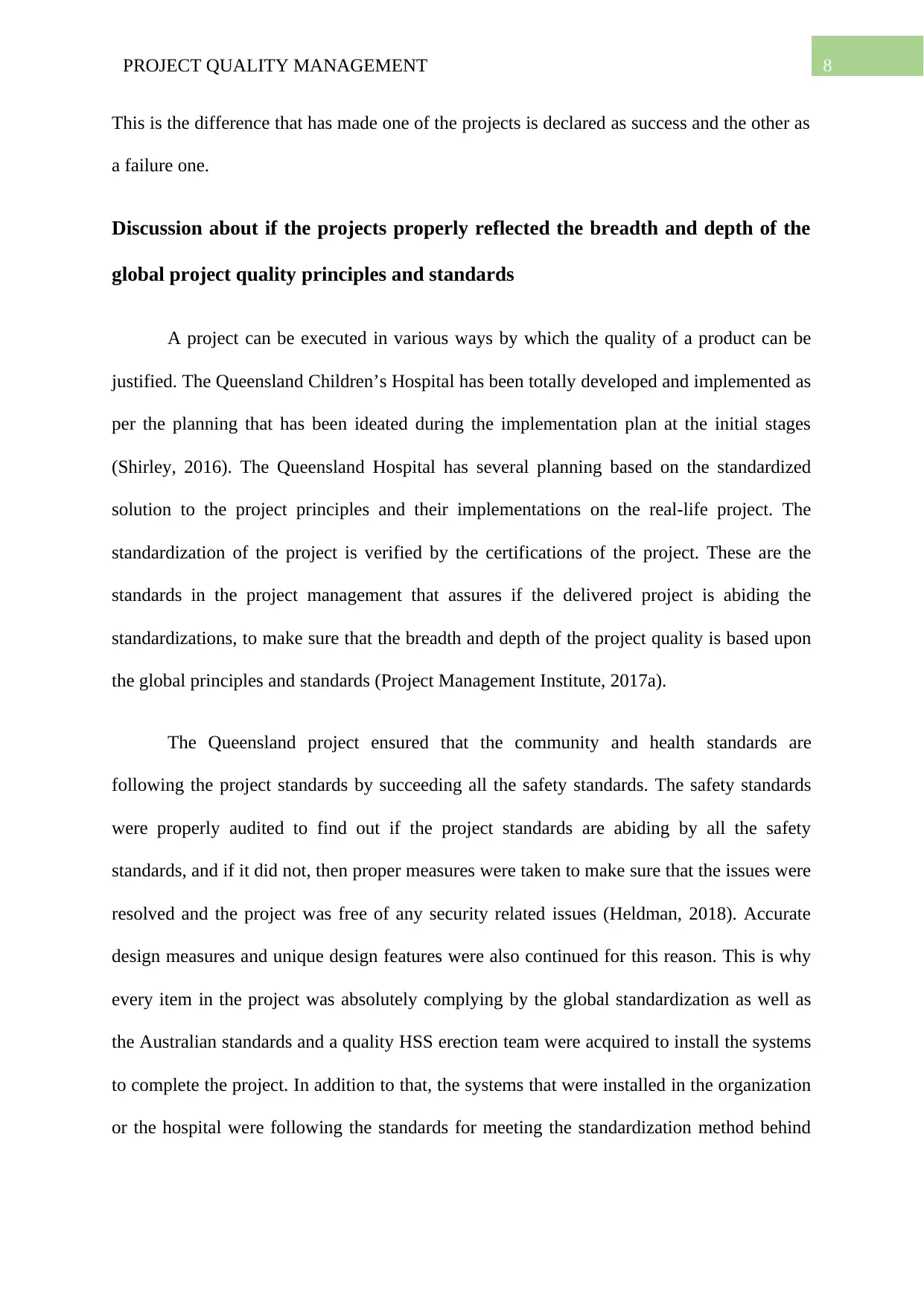
8PROJECT QUALITY MANAGEMENT
This is the difference that has made one of the projects is declared as success and the other as
a failure one.
Discussion about if the projects properly reflected the breadth and depth of the
global project quality principles and standards
A project can be executed in various ways by which the quality of a product can be
justified. The Queensland Children’s Hospital has been totally developed and implemented as
per the planning that has been ideated during the implementation plan at the initial stages
(Shirley, 2016). The Queensland Hospital has several planning based on the standardized
solution to the project principles and their implementations on the real-life project. The
standardization of the project is verified by the certifications of the project. These are the
standards in the project management that assures if the delivered project is abiding the
standardizations, to make sure that the breadth and depth of the project quality is based upon
the global principles and standards (Project Management Institute, 2017a).
The Queensland project ensured that the community and health standards are
following the project standards by succeeding all the safety standards. The safety standards
were properly audited to find out if the project standards are abiding by all the safety
standards, and if it did not, then proper measures were taken to make sure that the issues were
resolved and the project was free of any security related issues (Heldman, 2018). Accurate
design measures and unique design features were also continued for this reason. This is why
every item in the project was absolutely complying by the global standardization as well as
the Australian standards and a quality HSS erection team were acquired to install the systems
to complete the project. In addition to that, the systems that were installed in the organization
or the hospital were following the standards for meeting the standardization method behind
This is the difference that has made one of the projects is declared as success and the other as
a failure one.
Discussion about if the projects properly reflected the breadth and depth of the
global project quality principles and standards
A project can be executed in various ways by which the quality of a product can be
justified. The Queensland Children’s Hospital has been totally developed and implemented as
per the planning that has been ideated during the implementation plan at the initial stages
(Shirley, 2016). The Queensland Hospital has several planning based on the standardized
solution to the project principles and their implementations on the real-life project. The
standardization of the project is verified by the certifications of the project. These are the
standards in the project management that assures if the delivered project is abiding the
standardizations, to make sure that the breadth and depth of the project quality is based upon
the global principles and standards (Project Management Institute, 2017a).
The Queensland project ensured that the community and health standards are
following the project standards by succeeding all the safety standards. The safety standards
were properly audited to find out if the project standards are abiding by all the safety
standards, and if it did not, then proper measures were taken to make sure that the issues were
resolved and the project was free of any security related issues (Heldman, 2018). Accurate
design measures and unique design features were also continued for this reason. This is why
every item in the project was absolutely complying by the global standardization as well as
the Australian standards and a quality HSS erection team were acquired to install the systems
to complete the project. In addition to that, the systems that were installed in the organization
or the hospital were following the standards for meeting the standardization method behind
⊘ This is a preview!⊘
Do you want full access?
Subscribe today to unlock all pages.

Trusted by 1+ million students worldwide
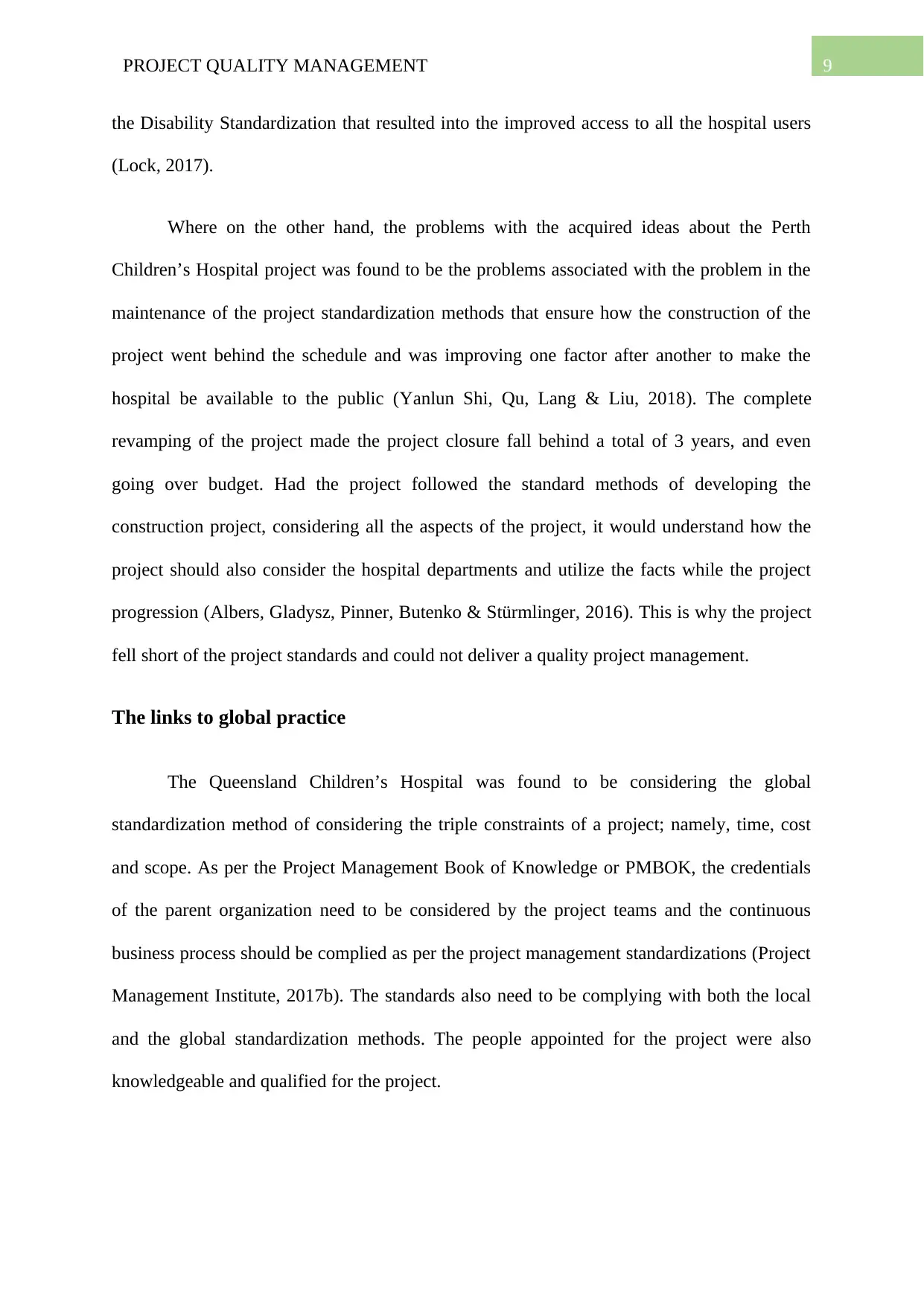
9PROJECT QUALITY MANAGEMENT
the Disability Standardization that resulted into the improved access to all the hospital users
(Lock, 2017).
Where on the other hand, the problems with the acquired ideas about the Perth
Children’s Hospital project was found to be the problems associated with the problem in the
maintenance of the project standardization methods that ensure how the construction of the
project went behind the schedule and was improving one factor after another to make the
hospital be available to the public (Yanlun Shi, Qu, Lang & Liu, 2018). The complete
revamping of the project made the project closure fall behind a total of 3 years, and even
going over budget. Had the project followed the standard methods of developing the
construction project, considering all the aspects of the project, it would understand how the
project should also consider the hospital departments and utilize the facts while the project
progression (Albers, Gladysz, Pinner, Butenko & Stürmlinger, 2016). This is why the project
fell short of the project standards and could not deliver a quality project management.
The links to global practice
The Queensland Children’s Hospital was found to be considering the global
standardization method of considering the triple constraints of a project; namely, time, cost
and scope. As per the Project Management Book of Knowledge or PMBOK, the credentials
of the parent organization need to be considered by the project teams and the continuous
business process should be complied as per the project management standardizations (Project
Management Institute, 2017b). The standards also need to be complying with both the local
and the global standardization methods. The people appointed for the project were also
knowledgeable and qualified for the project.
the Disability Standardization that resulted into the improved access to all the hospital users
(Lock, 2017).
Where on the other hand, the problems with the acquired ideas about the Perth
Children’s Hospital project was found to be the problems associated with the problem in the
maintenance of the project standardization methods that ensure how the construction of the
project went behind the schedule and was improving one factor after another to make the
hospital be available to the public (Yanlun Shi, Qu, Lang & Liu, 2018). The complete
revamping of the project made the project closure fall behind a total of 3 years, and even
going over budget. Had the project followed the standard methods of developing the
construction project, considering all the aspects of the project, it would understand how the
project should also consider the hospital departments and utilize the facts while the project
progression (Albers, Gladysz, Pinner, Butenko & Stürmlinger, 2016). This is why the project
fell short of the project standards and could not deliver a quality project management.
The links to global practice
The Queensland Children’s Hospital was found to be considering the global
standardization method of considering the triple constraints of a project; namely, time, cost
and scope. As per the Project Management Book of Knowledge or PMBOK, the credentials
of the parent organization need to be considered by the project teams and the continuous
business process should be complied as per the project management standardizations (Project
Management Institute, 2017b). The standards also need to be complying with both the local
and the global standardization methods. The people appointed for the project were also
knowledgeable and qualified for the project.
Paraphrase This Document
Need a fresh take? Get an instant paraphrase of this document with our AI Paraphraser
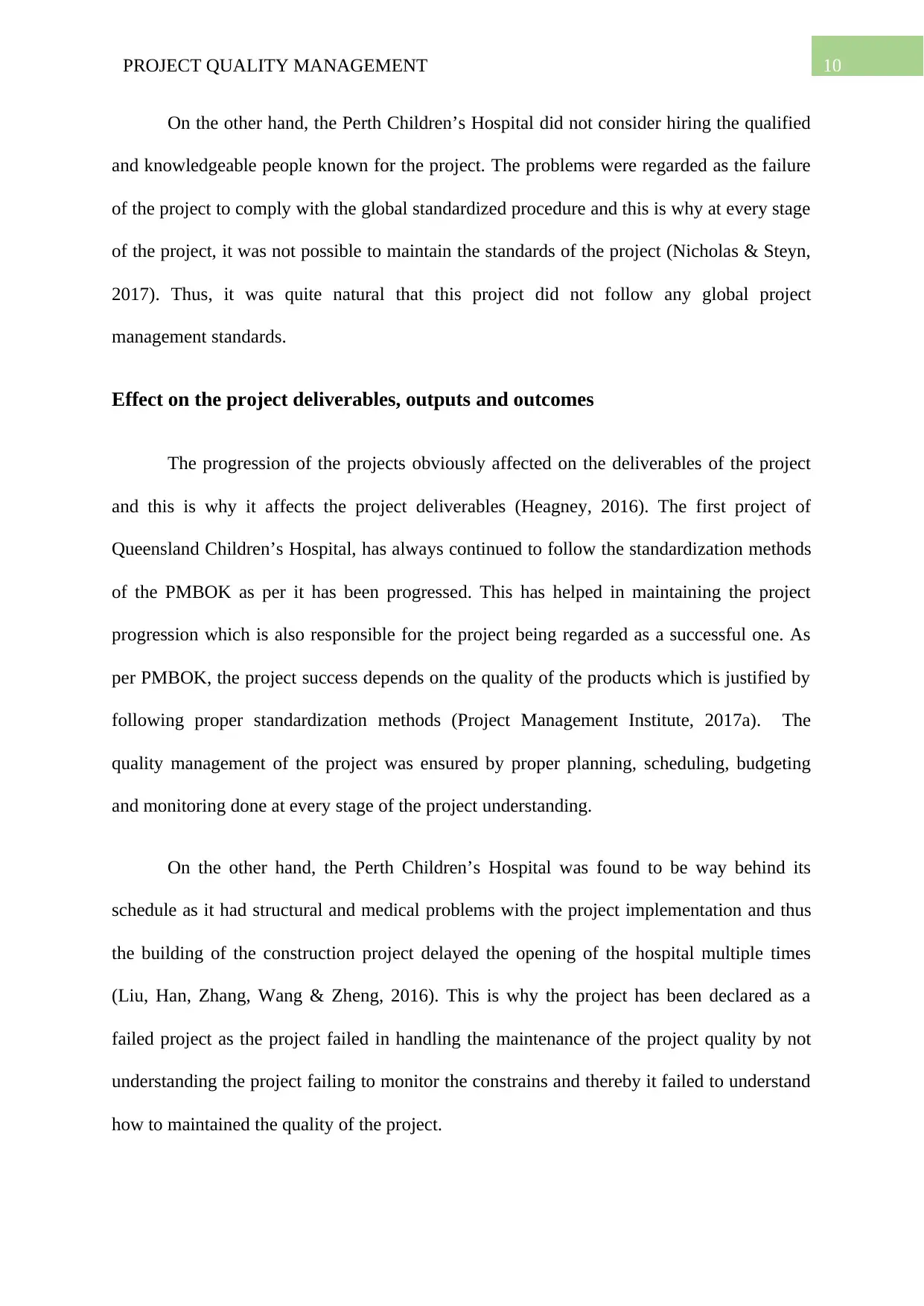
10PROJECT QUALITY MANAGEMENT
On the other hand, the Perth Children’s Hospital did not consider hiring the qualified
and knowledgeable people known for the project. The problems were regarded as the failure
of the project to comply with the global standardized procedure and this is why at every stage
of the project, it was not possible to maintain the standards of the project (Nicholas & Steyn,
2017). Thus, it was quite natural that this project did not follow any global project
management standards.
Effect on the project deliverables, outputs and outcomes
The progression of the projects obviously affected on the deliverables of the project
and this is why it affects the project deliverables (Heagney, 2016). The first project of
Queensland Children’s Hospital, has always continued to follow the standardization methods
of the PMBOK as per it has been progressed. This has helped in maintaining the project
progression which is also responsible for the project being regarded as a successful one. As
per PMBOK, the project success depends on the quality of the products which is justified by
following proper standardization methods (Project Management Institute, 2017a). The
quality management of the project was ensured by proper planning, scheduling, budgeting
and monitoring done at every stage of the project understanding.
On the other hand, the Perth Children’s Hospital was found to be way behind its
schedule as it had structural and medical problems with the project implementation and thus
the building of the construction project delayed the opening of the hospital multiple times
(Liu, Han, Zhang, Wang & Zheng, 2016). This is why the project has been declared as a
failed project as the project failed in handling the maintenance of the project quality by not
understanding the project failing to monitor the constrains and thereby it failed to understand
how to maintained the quality of the project.
On the other hand, the Perth Children’s Hospital did not consider hiring the qualified
and knowledgeable people known for the project. The problems were regarded as the failure
of the project to comply with the global standardized procedure and this is why at every stage
of the project, it was not possible to maintain the standards of the project (Nicholas & Steyn,
2017). Thus, it was quite natural that this project did not follow any global project
management standards.
Effect on the project deliverables, outputs and outcomes
The progression of the projects obviously affected on the deliverables of the project
and this is why it affects the project deliverables (Heagney, 2016). The first project of
Queensland Children’s Hospital, has always continued to follow the standardization methods
of the PMBOK as per it has been progressed. This has helped in maintaining the project
progression which is also responsible for the project being regarded as a successful one. As
per PMBOK, the project success depends on the quality of the products which is justified by
following proper standardization methods (Project Management Institute, 2017a). The
quality management of the project was ensured by proper planning, scheduling, budgeting
and monitoring done at every stage of the project understanding.
On the other hand, the Perth Children’s Hospital was found to be way behind its
schedule as it had structural and medical problems with the project implementation and thus
the building of the construction project delayed the opening of the hospital multiple times
(Liu, Han, Zhang, Wang & Zheng, 2016). This is why the project has been declared as a
failed project as the project failed in handling the maintenance of the project quality by not
understanding the project failing to monitor the constrains and thereby it failed to understand
how to maintained the quality of the project.
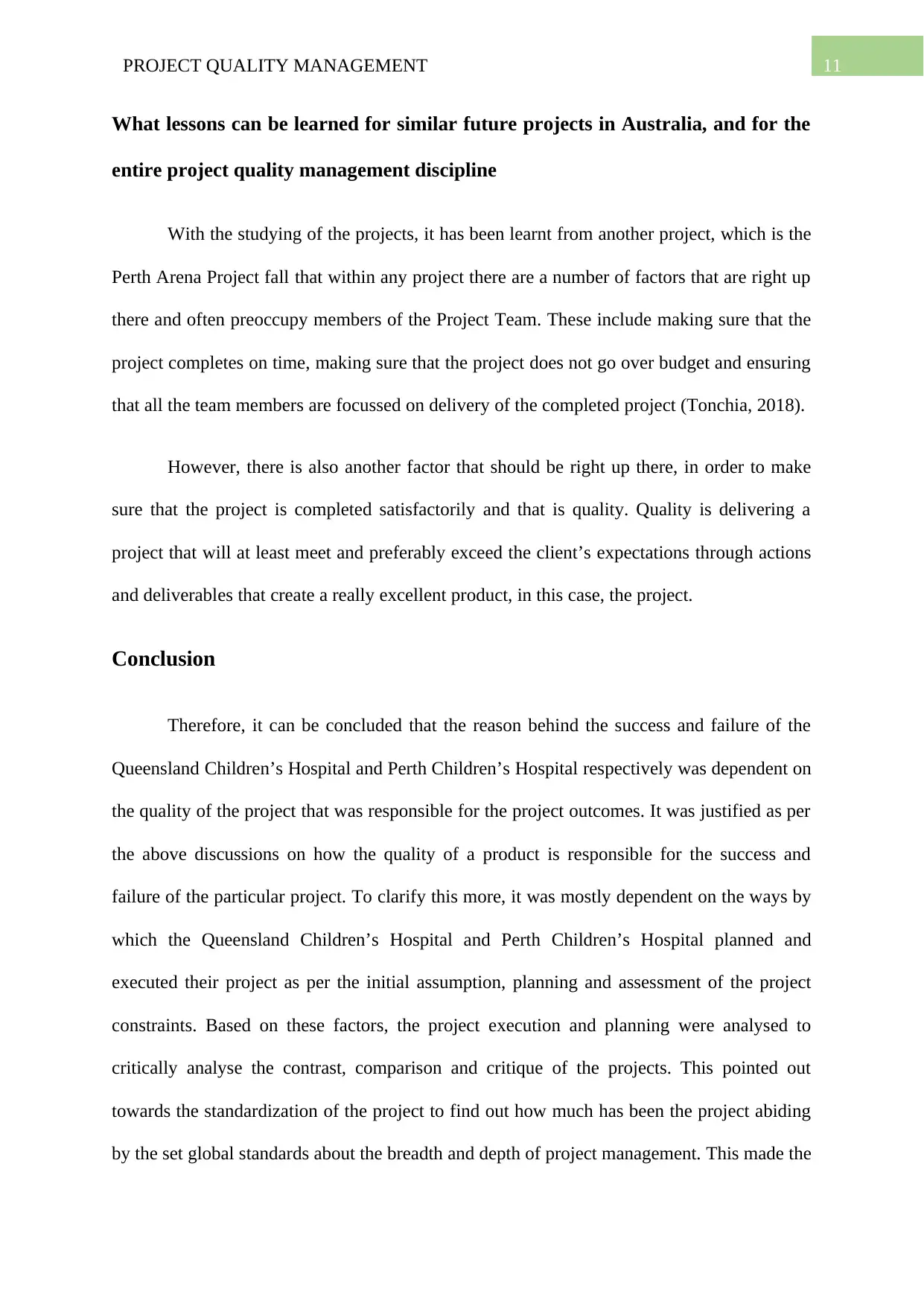
11PROJECT QUALITY MANAGEMENT
What lessons can be learned for similar future projects in Australia, and for the
entire project quality management discipline
With the studying of the projects, it has been learnt from another project, which is the
Perth Arena Project fall that within any project there are a number of factors that are right up
there and often preoccupy members of the Project Team. These include making sure that the
project completes on time, making sure that the project does not go over budget and ensuring
that all the team members are focussed on delivery of the completed project (Tonchia, 2018).
However, there is also another factor that should be right up there, in order to make
sure that the project is completed satisfactorily and that is quality. Quality is delivering a
project that will at least meet and preferably exceed the client’s expectations through actions
and deliverables that create a really excellent product, in this case, the project.
Conclusion
Therefore, it can be concluded that the reason behind the success and failure of the
Queensland Children’s Hospital and Perth Children’s Hospital respectively was dependent on
the quality of the project that was responsible for the project outcomes. It was justified as per
the above discussions on how the quality of a product is responsible for the success and
failure of the particular project. To clarify this more, it was mostly dependent on the ways by
which the Queensland Children’s Hospital and Perth Children’s Hospital planned and
executed their project as per the initial assumption, planning and assessment of the project
constraints. Based on these factors, the project execution and planning were analysed to
critically analyse the contrast, comparison and critique of the projects. This pointed out
towards the standardization of the project to find out how much has been the project abiding
by the set global standards about the breadth and depth of project management. This made the
What lessons can be learned for similar future projects in Australia, and for the
entire project quality management discipline
With the studying of the projects, it has been learnt from another project, which is the
Perth Arena Project fall that within any project there are a number of factors that are right up
there and often preoccupy members of the Project Team. These include making sure that the
project completes on time, making sure that the project does not go over budget and ensuring
that all the team members are focussed on delivery of the completed project (Tonchia, 2018).
However, there is also another factor that should be right up there, in order to make
sure that the project is completed satisfactorily and that is quality. Quality is delivering a
project that will at least meet and preferably exceed the client’s expectations through actions
and deliverables that create a really excellent product, in this case, the project.
Conclusion
Therefore, it can be concluded that the reason behind the success and failure of the
Queensland Children’s Hospital and Perth Children’s Hospital respectively was dependent on
the quality of the project that was responsible for the project outcomes. It was justified as per
the above discussions on how the quality of a product is responsible for the success and
failure of the particular project. To clarify this more, it was mostly dependent on the ways by
which the Queensland Children’s Hospital and Perth Children’s Hospital planned and
executed their project as per the initial assumption, planning and assessment of the project
constraints. Based on these factors, the project execution and planning were analysed to
critically analyse the contrast, comparison and critique of the projects. This pointed out
towards the standardization of the project to find out how much has been the project abiding
by the set global standards about the breadth and depth of project management. This made the
⊘ This is a preview!⊘
Do you want full access?
Subscribe today to unlock all pages.

Trusted by 1+ million students worldwide
1 out of 16
Related Documents
Your All-in-One AI-Powered Toolkit for Academic Success.
+13062052269
info@desklib.com
Available 24*7 on WhatsApp / Email
![[object Object]](/_next/static/media/star-bottom.7253800d.svg)
Unlock your academic potential
Copyright © 2020–2025 A2Z Services. All Rights Reserved. Developed and managed by ZUCOL.




